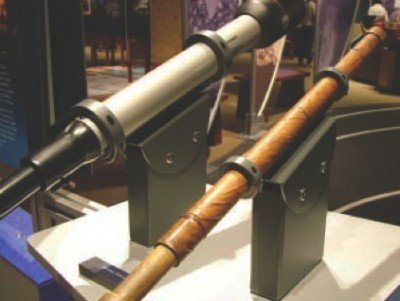Galileo’s View: The astronomer’s telescope is recreated
Almost 400 years after the 17th century scientist’s discoveries, an interdisciplinary team of scholars in Florence spent two years recreating the instrument Galileo Galilei used to view the night sky.
The reconstructed telescope was unveiled in March 2009 at the Florence Museum of the History of Science and the national institutes of applied optics, nuclear physics and astrophysics.

of History and Science.

original telescope
The team, comprised of astronomers, scientists and historians, wanted to reconstruct the telescope for the International Year of Astronomy, which marks the 400th anniversary of Galileo’s radical discoveries.
To achieve this goal, the team collaborated with the Experimental Glass Station in Murano. There they wre able to use the plans dictated in Galileo’s 1610 treatise Sidereus Nuncius (Starry Messenger), where he recorded his first observations along with formal instructions on the construction of his first telescope.
Galileo designed and built his first telescope in 1608, based on descriptions from the Netherlands, where the first telsecope was invented.
His original lens was able to magnify objects threefold, while his later version was created with an ability to magnify objects 32 times their natural size. His technology put him at a unique advantage, as he was one of the onlypeople with the ability to study the sky at that proximity.
Francesco Palla, director of the National Institute of Astrophysics’ Arcetri Observatory, said that the team’s astronomers had “almost finished” recording the observations of the objects Galileo would have seen with his 1609 telescope.
“We have observed the moon, the satellites of Jupiter and the phases of Venus,’’ Palla said.
Galileo used his telescope to record regular views of the night’s sky in 1609 and, in this way, discovered the three moons of Jupiter in 1610. He assumed at first that they were stars, but later changed his hypothesis because of their continual shifting of positions. This and his ability to observe the various phases of Venus are believed to have played a major role in his 1612 conclusion that the Sun, not the Earth, was at the center of the Universe.
The Catholic Church at the time opposed this conclusion, and attempted to thwart the inventor’s hypothesis.
In 1633 he was convicted of heresy and thus a ban was implemented upon all remaining publication or reprinting of his works. Thereafter, he was placed on house arrest, where he was forced to remain until his death in 1642.
